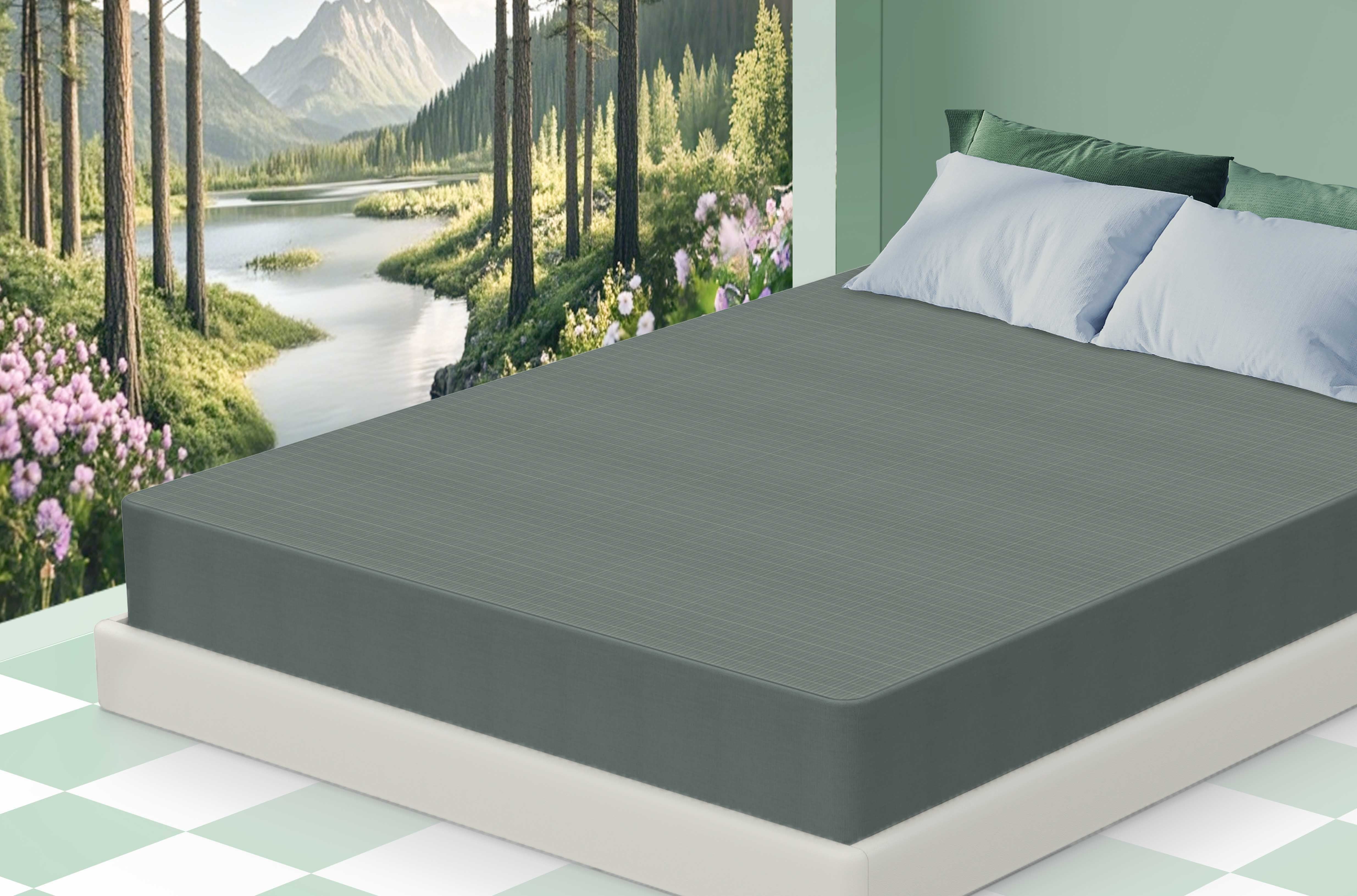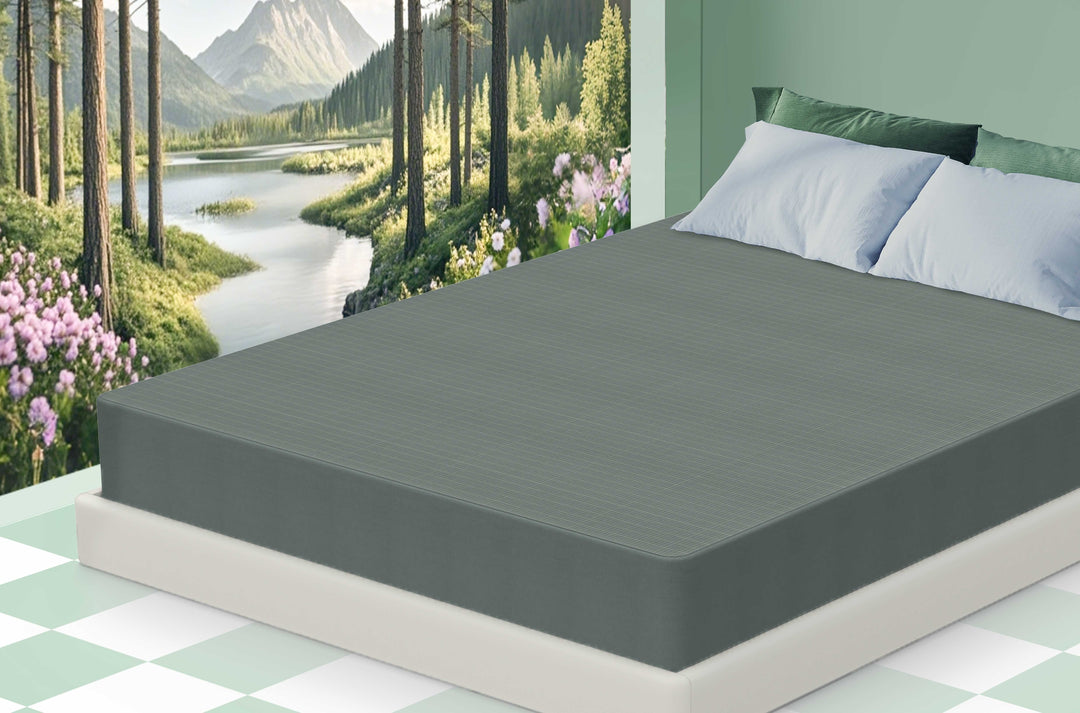Ankylosing Spondylitis Self-Care: Evidence-Based Methods for Long-Term Relief
Living with ankylosing spondylitis means constantly battling stiffness, pain, and fatigue—but what if the most powerful treatments aren't found in a prescription bottle? Research shows that strategic ankylosing spondylitis self-care can reduce AS symptoms by up to 40%, yet most people unknowingly make their condition worse with outdated advice.
The difference between thriving and merely surviving with AS often comes down to daily choices that either fuel inflammation or fight it. Whether you're in the early stages or managing severe cases, proper self-care makes a big difference.
Ready to take control of your ankylosing spondylitis symptoms? Let's explore the evidence-based strategies that deliver real, lasting pain relief.

Healthy Spine vs. Ankylosing Spondylitis
Source: MedlinePlus
Exercise Regularly for Ankylosing Spondylitis
Staying active is one of the most effective ways to manage ankylosing spondylitis (AS), a form of inflammatory arthritis. The right exercises can improve posture, spinal mobility, and reduce stiffness—while the wrong ones may worsen inflammation or increase the risk of injury.
✅ Recommended Exercises
These exercises help improve flexibility, strength, and overall function without putting excessive strain on the spine or joints:
-
Posture Training: Wall sits, chin tucks, and shoulder blade squeezes help maintain upright posture.
-
Stretching: Daily spinal and hip stretches maintain flexibility and reduce stiffness.
-
Low-Impact Cardio: Swimming, walking, and cycling improve cardiovascular health without stressing joints.
-
Yoga and Pilates: Gentle routines increase spinal mobility and core strength.
-
Breathing Exercises: Deep breathing helps maintain chest expansion, which is often reduced in AS.

❌ Exercises to Avoid
Certain activities can aggravate symptoms or cause injury due to the rigidity of the spine:
-
High-Impact Sports: Running, jumping, or contact sports can increase joint stress and risk of spinal fractures.
-
Heavy Weightlifting: Exercises like squats or deadlifts with heavy weights may strain the spine and worsen arthritis discomfort.
-
Twisting or Jerky Movements: Activities like golf or certain gym workouts involving spinal rotation can worsen pain.
-
Prolonged Sedentary Exercise: Long-distance cycling without breaks can stiffen the spine and hips.

🎯 Targeted Exercises for Common AS Pain Areas
AS can affect many areas beyond the spine. These health tips offer relief for specific pain points:
-
Rib Pain (Costochondritis): Try deep breathing, side stretches, and wall push-ups to improve chest mobility. Swimming backstroke also supports rib cage flexibility.
-
Shoulder Pain: Pendulum swings, cross-body stretches, and resistance band movements help restore motion. Doorway stretches open the chest and improve posture.
-
Ankle Inflammation: Toe alphabet movements, wall calf stretches, and resistance band work maintain mobility. Balance drills build joint stability.
-
Tailbone (Coccyx) Pain: Cat-cow stretches, pelvic tilts, and modified child’s pose offer relief. Use a donut cushion when sitting to reduce pressure.
Key principles for AS exercise:
-
Move daily, even just 10 minutes
-
Never force through sharp pain signals
-
Warm up thoroughly (heat therapy helps)
-
Focus on the range of motion over strength
-
Water exercises at your local pool reduce stress on joints
⭐️ Consistency beats intensity: Start slowly with 2-3 exercises per problem area, building gradually to prevent stiffness and joint damage.
Morning Routines That Combat Stiffness
The first hour sets the tone for your entire day. A strategic morning routine can reduce AS stiffness, helping you maintain a normal life. The 5-step wake-up protocol:

Pre-rise prep (still in bed):
-
Gentle ankle pumps and knee bends
-
Spinal twists while lying down
-
Deep breathing to oxygenate tissues
-
Apply a heating pad to the stiffest affected joint stiffness
The warm shower strategy:
-
Start lukewarm, gradually increase the heat
-
Let hot water hit the spine for 5+ minutes
-
Gentle neck rolls under a water stream
-
End with 30 seconds of cooler water (reduces inflammation)
Movement sequence (10 minutes):
-
Cat-cow stretches: 10 repetitions
-
Standing forward fold with bent knees
-
Gentle spinal twists in a chair
-
Wall slides for posture reset
Mindful nutrition:
-
Anti-inflammatory smoothie or green tea
-
Avoid inflammatory foods at breakfast
-
Take morning supplements with food
-
Hydrate immediately (dehydration worsens stiffness)
Mental preparation:
-
5-minute meditation or breathing exercise
-
Set realistic daily movement goals
-
Plan rest breaks throughout the day
-
Practice gratitude (reduces pain perception)
💡 Game-changer tips: Prep everything the night before—clothes, supplements, breakfast. Reducing morning decisions saves energy for movement. Many AS patients find sleeping on a hard mattress with silk pajamas reduces friction and morning discomfort. A warm bath before bed also helps reduce next-day stiffness.
Apply Heat and Cold Therapy for Ankylosing Spondylitis Pain Relief
The age-old debate—heat or ice pack for AS pain?—has a surprisingly nuanced answer. Both have their place, but timing and location make all the difference.
🧊 Cold Therapy: Use for Acute Flare-Ups
-
Acute pain during flare-ups with visible swelling
-
Post-exercise inflammation (first 24-48 hours)
-
Enthesitis points (where ligaments attach to bone)
-
Peripheral joint inflammation

🔥 Heat Therapy: Best for Most AS Scenarios
-
Morning stiffness: Apply heat 20-30 minutes before getting up
-
Chronic spine pain: Consistent warmth reduces muscle tension
-
General pain relief: Effective for arthritis, back, hip, pelvic, neck, and joint pain
-
Pre-physical activity prep: Loosens tight areas before movement
-
Nighttime relief: Helps relax muscles for better sleep

Modern heating solutions like Homlyns' Graphene Weighted Heating Pad offer precise control with 10 heat levels and timer settings. The graphene technology even provides heat distribution—crucial for AS patients who need consistent warmth across larger areas like the full body or neck, shoulders, and back. For those exploring the connection between ankylosing spondylitis and heating pads, this innovative design provides targeted comfort and deeper, more consistent relief.
💡 Pro tips for AS warriors: Many find alternating helpful—ice pack for acute inflammation, then heat for residual stiffness. Never use heat on actively inflamed, red, or swollen affected areas—this can increase blood flow and worsen inflammation. Whether using heat or ice, limit sessions to 20 minutes. Longer exposure can worsen inflammation or damage skin.
Eat an Anti-Inflammatory Diet for AS
What you eat directly impacts AS inflammation and your immune system. Research shows specific dietary changes can reduce pain and inflammatory markers by up to 30% within 8-12 weeks.
✅ The AS-friendly plate includes:
-
Fatty fish (salmon, mackerel, sardines) 2-3x weekly
-
Colorful vegetables—especially leafy greens and bell peppers
-
Whole grains over refined carbs
-
Olive oil as the primary cooking fat
-
Nuts and seeds (walnuts, flaxseeds, chia)
-
Low-starch foods to minimize gut-triggered inflammation
The Mediterranean diet consistently outperforms others for AS management. One study showed participants following this pattern experienced a reduction in morning pain and stiffness and improved spinal mobility.

❌ Foods that fuel inflammation:
-
Processed meats and red meat (limit to 1-2 servings/week)
-
Sugar-sweetened beverages and refined sugars
-
Trans fats and excessive omega-6 oils
-
High-sodium processed foods
-
Alcohol (especially beer) triggers flares in many

⚠️ Hidden triggers to watch:
-
Nightshade vegetables (tomatoes, peppers, eggplant) affect some people
-
Gluten sensitivity occurs in 5-10% of AS patients
-
Dairy can increase inflammation in lactose-intolerant individuals
Start with an elimination diet for 3-4 weeks, then reintroduce foods systematically. Keep a symptom journal—you'll quickly identify your personal triggers. No single diet works for everyone with AS, but reducing processed foods helps universally support overall health.
Vitamins and Supplements for Ankylosing Spondylitis
Forget the wellness blogs pushing unproven supplements. Real rheumatology research has identified specific natural remedies that measurably reduce AS inflammation and relieve pain.
Turmeric (Curcumin)
Turmeric is one of the most researched natural remedies for inflammatory conditions. Its active compound, curcumin, has shown strong anti-inflammatory effects and may help reduce joint pain and stiffness—especially when taken with black pepper, which enhances absorption.

Omega-3 fatty acids
Omega-3s are well known for their ability to combat chronic inflammation. Regular supplementation has been linked to improved joint function, better spinal mobility, and reduced disease activity. Fish oil and plant-based sources like algae both offer benefits for arthritis and general joint health

Probiotics
Recent studies have highlighted a strong connection between gut health and ankylosing spondylitis. Certain probiotic strains, such as Lactobacillus casei, have been shown to reduce arthritis scores and lower levels of pro-inflammatory cytokines. While human studies are still limited, early findings suggest that supporting a healthy gut microbiome may help ease AS severity and complement other treatment strategies.
Other evidence-backed options:
-
Vitamin D: Deficiency is common in those who develop ankylosing spondylitis; supplementation supports bone health
-
Boswellia serrata: Anti-inflammatory effects for painful joints and arthritis
-
Ginger extract: Comparable anti-inflammatory effects to NSAIDs
⚠️ Critical note: These remedies work alongside conventional treatment, not instead of it. They may help manage arthritis and spondylitis, but always discuss additions with your doctor—some supplements interact with AS medications like biologic drugs or other drugs, such as methotrexate.
Manage Stress Mindfully
Living with ankylosing spondylitis (AS)—a chronic spondyloarthritis disease—presents ongoing physical challenges, but emotional well-being plays an equally important role in overall health. Chronic pain, limited mobility, and uncertainty about flare-ups can contribute to anxiety, frustration, or depression. That’s why developing healthy stress management habits is essential.
Mindful practices like deep breathing, meditation, and progressive muscle relaxation can help calm the nervous system and reduce stress-induced inflammation. Even setting aside 10 minutes a day for quiet reflection or gratitude journaling can build emotional resilience and support your mental health.

Consider these additional tools:
-
Guided meditation apps (like Calm or Headspace)
-
Cognitive Behavioral Therapy (CBT) to reshape negative thought patterns
-
Creative outlets such as drawing, music, or gardening
-
Connection with others through support groups or online communities
Reducing stress not only improves your mood—it can also lower the frequency and intensity of spondyloarthritis flare-ups, supporting both physical and emotional health.
Prioritize Quality Sleep
Sleep is a critical component of spondylitis self-care. Poor or interrupted rest can increase pain sensitivity, fatigue, and emotional stress—all of which worsen symptoms of this chronic disease. Many people with AS experience stiffness or discomfort at night, especially in the early morning hours.

To promote better sleep:
-
Stick to a consistent sleep schedule, even on weekends
-
Create a calming bedtime routine—dim the lights, disconnect from screens, and wind down with gentle stretches or reading
-
Invest in supportive sleep equipment, like a firm mattress and ergonomic pillows to maintain spinal alignment
-
Use a heating pad or weighted blanket to ease muscle tension and promote relaxation
If pain continues to interrupt sleep, consult your doctor about nighttime pain relief or management options tailored to spondyloarthritis. Quality sleep isn’t just restful—it plays a crucial role in reducing inflammation, boosting mental clarity, and enhancing your overall health.
Treatment Guidelines Your Doctor Might Miss
Even well-meaning rheumatologists can overlook these crucial AS management strategies that significantly impact daily life, especially in early adulthood when navigating the disease for the first time. These often-missed approaches can make a significant difference in your daily life and long-term health.
Breathing exercises aren't optional
They're essential. Spondyloarthritis restricts chest expansion; specific breathing techniques maintain lung capacity. Practice diaphragmatic breathing 3x daily to prevent respiratory complications.

Good Posture Correction
It goes beyond "sit up straight." Use these posture tips:
-
Chin tucks every hour
-
Standing against the walls to check alignment
-
Ergonomic workspace assessment
-
Sleeping position optimization (never on stomach)

Inflammation-Infection Connection
Any infection can trigger flares. Stay current on:
-
Dental cleanings (every 4 months, not 6)
-
Flu and pneumonia vaccines
-
Prompt treatment of UTIs or respiratory infections
-
Gut health maintenance

Work Modifications
Occupational challenges require more than a good chair.
-
Microbreak timers every 30 minutes (avoid sitting for long periods)
-
Variable height desks (not just standing)
-
Voice-to-text software to reduce typing
-
Assistive devices when needed
-
FMLA paperwork for flare management

✅ Tips for Long-Term Management:
-
Track what works: Keep a record of effective strategies and share them with your doctor during appointments.
-
Advocate for yourself: Don't accept "just live with it" as treatment advice. Push your doctor for adjustments that reflect your current needs. The main symptoms may vary between individuals, but consistent self-care benefits everyone.
-
Watch for eye symptoms: In rare cases, eye inflammation causing blurred vision requires immediate attention—don't wait for your next doctor appointment.
-
Keeping active within your limits: Gentle, consistent movement helps maintain hip joints and other joints' flexibility.
-
Schedule regular check-ups: Your treatment plan should evolve alongside your disease. Monitor and update it with your healthcare team.
-
Join a support community: Some find relief visiting axial spondyloarthritis support groups, especially during late adolescence or the second half of life, when symptoms often change.
Ready to Make AS Self-Care Simple with Homlyns?
Living with AS means becoming your own best advocate. The strategies we've covered—from targeted remedies to morning routines—transform overwhelming symptoms into manageable daily practices. Your life span doesn't have to be compromised by AS when you take control.
Key takeaways for AS self-care success:
-
Combine natural remedies (turmeric, omega-3s) with conventional treatment
-
Heat therapy beats ice for most AS symptoms
-
Anti-inflammatory diet changes deliver measurable results
-
Targeted exercises prevent problem areas from worsening
-
Strategic morning routines cut stiffness in half
-
Document what works—you know your body best
Ready to upgrade your heat therapy game? Homlyns' graphene heating pads deliver the consistent, penetrating warmth AS warriors need most. With 10 precise heat settings and weighted comfort, they're designed for the long-haul relief that makes daily self-care actually work. When it comes to ankylosing spondylitis and heating pads, this solution offers the kind of targeted, reliable heat therapy that supports real comfort and mobility.
Reference:
- Amdekar S, Singh V, Singh R, Sharma P, Keshav P, Kumar A. Lactobacillus casei reduces the inflammatory joint damage associated with collagen-induced arthritis (CIA) by reducing the pro-inflammatory cytokines: Lactobacillus casei: COX-2 inhibitor. J Clin Immunol. 2011 Apr;31(2):147-54. doi: 10.1007/s10875-010-9457-7. Epub 2010 Sep 14. PMID: 20838859.
- Kocyigit BF, Akyol A. Vitamin D levels in patients with ankylosing spondylitis: Is it related to disease activity?. Pak J Med Sci. 2018;34(5):1209-1214. doi:10.12669/pjms.345.15739
- Mamatha K, Prabhakaran P, Syam Das S, Kanjoormana Aryan M, Thomas J. A full-spectrum Boswellia serrata extract with enhanced bioavailability, and its co-delivered system with curcumin alleviate pain and stiffness associated with moderate spondylitis: a randomized double-blind, placebo-controlled, 3-arm study. Front Pharmacol. 2025 Jul 1;16:1577429. doi: 10.3389/fphar.2025.1577429. PMID: 40667507; PMCID: PMC12260406.
- Sundström B, Stålnacke K, Hagfors L, Johansson G. Supplementation of omega-3 fatty acids in patients with ankylosing spondylitis. Scand J Rheumatol. 2006 Sep-Oct;35(5):359-62. doi: 10.1080/03009740600844357. PMID: 17062435.
- Zeng L, Yang T, Yang K, Yu G, Li J, Xiang W, Chen H. Efficacy and Safety of Curcumin and Curcuma longa Extract in the Treatment of Arthritis: A Systematic Review and Meta-Analysis of Randomized Controlled Trial. Front Immunol. 2022 Jul 22;13:891822. doi: 10.3389/fimmu.2022.891822. PMID: 35935936; PMCID: PMC9353077.
















Helps me a lot, thanks
Leave a comment